Birch Barbara M. English L2 Reading: Getting to the Bottom
Подождите немного. Документ загружается.


118
CHAPTER
8
Chinese
(isolating)
A.
one
morpheme
per
word
segmentable
morphemes
D.
Turkish
(agglutinating)
nonsegmentable
morphemes
B.
Spanish
(fusional)
C.
Tuscarora
(poly
synthetic)
many
morphemes
per
word
FIG.
8.2 A
continuum
of
morphological variation
in the
world's
languages.
Adapted
from
Comrie,
1981,
pp.
39-49,
and
used
by
permission
of the
Uni-
versity
of
Chicago
Press.
pound words made
up of two
morphemes,
the
typical word
has one
segmentable morpheme. Languages
at
point
B are
called
fusional;
nor-
mally
words
will
have more than
one
morpheme
per
word
and the
mor-
phemes
often cannot
be
easily broken down into components. Languages
at
point
C are
called
polysynthetic;
words
can be
made
up of
many mor-
phemes,
but the
individual morphemes
may be
hard
to
separate out. Lan-
guages
at
point
D are
called
agglutinating;
there
are
many morphemes
and
it
is
easy
to
segment
the
morphemes
within
a
word.
In
general, languages
can be
characterized
by how
they
fall
within
the
quadrants formed
by the
lines
on the
chart. Keep
in
mind that
any
time
a
linguist sets
up a
neat
di-
chotomy
such
as
this one,
he or she finds
that
it is
sometimes
difficult
to
wrestle
the
world's languages into
the
perfect position. Languages,
the ul-
timate
human creations, resist neat
and
tidy
classifications.
Vietnamese,
for
instance,
is an
isolating language,
in
which each word
usually
has one
morpheme. Comrie
(1981)
gave this example
of a
Vietnam-
ese
sentence
(in
which
I
have omitted some phonetic markings):
Khi
toi den nha ban
toi,
chung
toi bat
dau
lam bai
when
I
come house friend
I
PLURAL
I
begin
do
lessons
"When
I
came
to my
friend's house,
we
began
to do
lessons."
(p. 40)
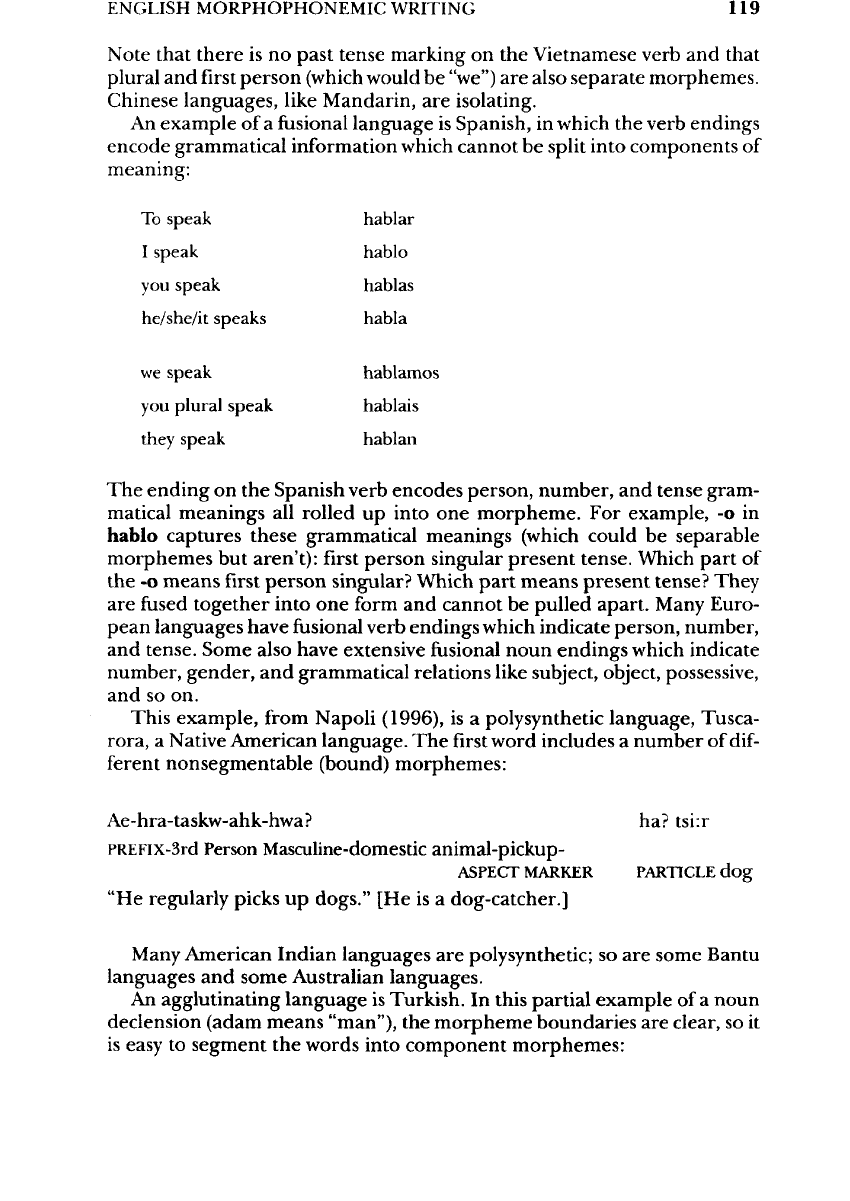
ENGLISH
MORPHOPHONEMIC WRITING
119
Note
that there
is no
past tense marking
on the
Vietnamese verb
and
that
plural
and first
person
(which
would
be
"we")
are
also separate
morphemes.
Chinese
languages, like Mandarin,
are
isolating.
An
example
of a
fusional
language
is
Spanish,
in
which
the
verb endings
encode grammatical information
which
cannot
be
split into components
of
meaning:
To
speak hablar
I
speak hablo
you
speak hablas
he/she/it speaks
habla
we
speak
hablamos
you
plural speak hablais
they
speak hablan
The
ending
on the
Spanish verb encodes person, number,
and
tense gram-
matical
meanings
all
rolled
up
into
one
morpheme.
For
example,
-o in
hablo captures these grammatical meanings
(which
could
be
separable
morphemes
but
aren't):
first
person singular present tense. Which part
of
the -o
means
first
person
singular? Which
part
means present tense? They
are
fused
together into
one
form
and
cannot
be
pulled apart.
Many
Euro-
pean languages have
fusional
verb endings which indicate person, number,
and
tense. Some also have extensive
fusional
noun endings which indicate
number,
gender,
and
grammatical relations like subject, object, possessive,
and so on.
This example, from Napoli
(1996),
is a
poly
synthetic
language, Tusca-
rora,
a
Native American language.
The first
word includes
a
number
of
dif-
ferent
nonsegmentable (bound) morphemes:
Ae-hra-taskw-ahk-hwa?
ha?
tsi:r
PREFIX-3rd
Person
Masculine-domestic
animal-pickup-
ASPECT
MARKER
PARTICLE
dog
"He
regularly picks
up
dogs."
[He is a
dog-catcher.]
Many
American Indian languages
are
polysynthetic;
so are
some Bantu
languages
and
some Australian languages.
An
agglutinating language
is
Turkish.
In
this partial example
of a
noun
declension
(adam means "man"),
the
morpheme boundaries
are
clear,
so it
is
easy
to
segment
the
words into component morphemes:
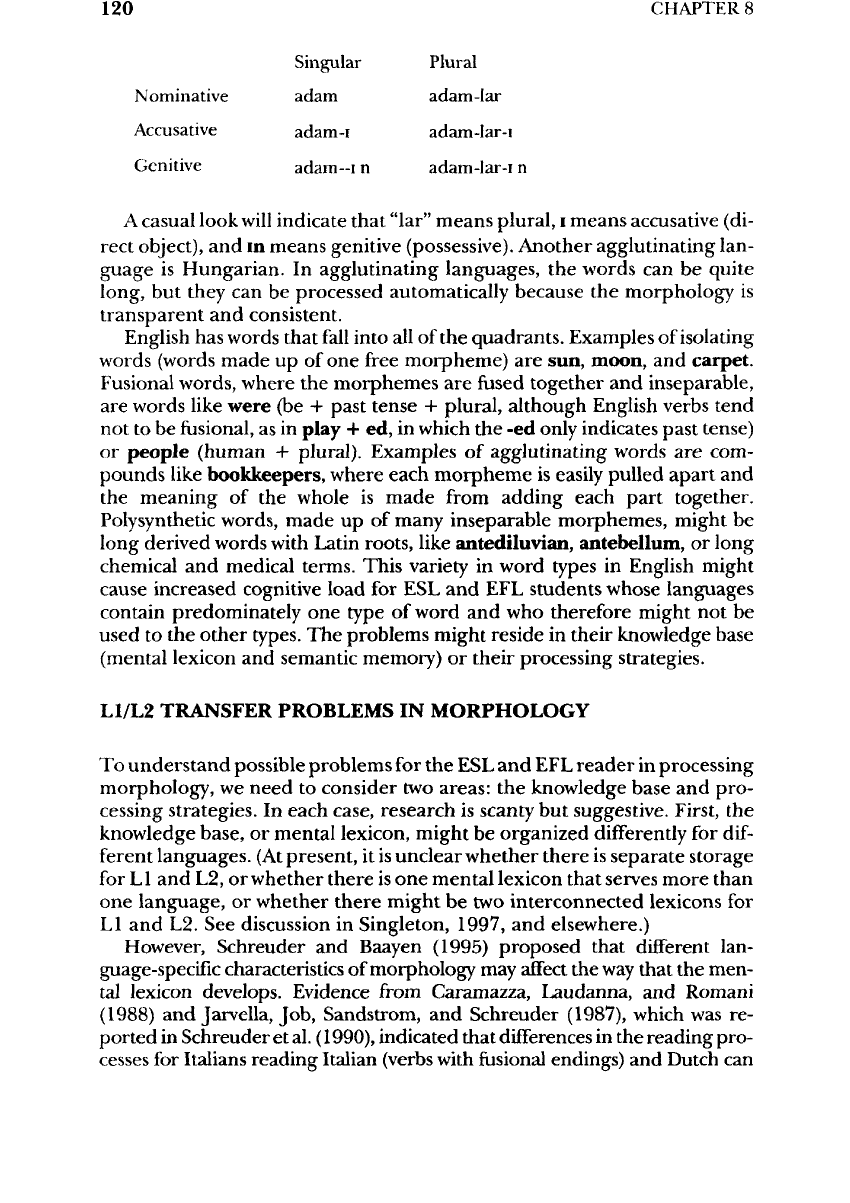
120
CHAPTERS
Singular
Plural
Nominative
adam
adam-lar
Accusative
adam-i
adam-Iar-i
Genitive
adam—i
n
adam-lar-i
n
A
casual
look
will
indicate that
"lar"
means plural,
i
means accusative (di-
rect
object),
and
in
means genitive (possessive). Another agglutinating lan-
guage
is
Hungarian.
In
agglutinating languages,
the
words
can be
quite
long,
but
they
can be
processed automatically because
the
morphology
is
transparent
and
consistent.
English
has
words that
fall
into
all of the
quadrants. Examples
of
isolating
words
(words
made
up of one
free
morpheme)
are
sun, moon,
and
carpet.
Fusional
words, where
the
morphemes
are
fused
together
and
inseparable,
are
words like were
(be +
past tense
+
plural, although English verbs tend
not to be
fusional,
as in
play
+ ed, in
which
the -ed
only indicates past tense)
or
people
(human
+
plural). Examples
of
agglutinating words
are
com-
pounds like bookkeepers, where each morpheme
is
easily pulled apart
and
the
meaning
of the
whole
is
made
from
adding each part together.
Polysynthetic
words, made
up of
many inseparable morphemes, might
be
long derived words
with
Latin roots, like antediluvian, antebellum,
or
long
chemical
and
medical terms.
This
variety
in
word types
in
English might
cause
increased cognitive load
for ESL and EFL
students whose languages
contain predominately
one
type
of
word
and who
therefore might
not be
used
to the
other
types.
The
problems might
reside
in
their
knowledge base
(mental
lexicon
and
semantic memory)
or
their processing strategies.
L1/L2
TRANSFER PROBLEMS
IN
MORPHOLOGY
To
understand possible problems
for the
ESL
and EFL
reader
in
processing
morphology,
we
need
to
consider
two
areas:
the
knowledge base
and
pro-
cessing
strategies.
In
each case,
research
is
scanty
but
suggestive. First,
the
knowledge
base,
or
mental lexicon, might
be
organized
differently
for
dif-
ferent
languages.
(At
present,
it is
unclear whether there
is
separate storage
for
LI
and L2, or
whether there
is one
mental lexicon that serves more than
one
language,
or
whether
there
might
be two
interconnected
lexicons
for
LI
and L2. See
discussion
in
Singleton, 1997,
and
elsewhere.)
However,
Schreuder
and
Baayen (1995) proposed that
different
lan-
guage-specific
characteristics
of
morphology
may
affect
the
way
that
the
men-
tal
lexicon develops. Evidence
from
Caramazza,
Laudanna,
and
Romani
(1988)
and
Jarvella,
Job,
Sandstrom,
and
Schreuder (1987),
which
was re-
ported
in
Schreuder
et
al.
(1990),
indicated that
differences
in the
reading pro-
cesses
for
Italians reading Italian
(verbs
with
fusional
endings)
and
Dutch
can
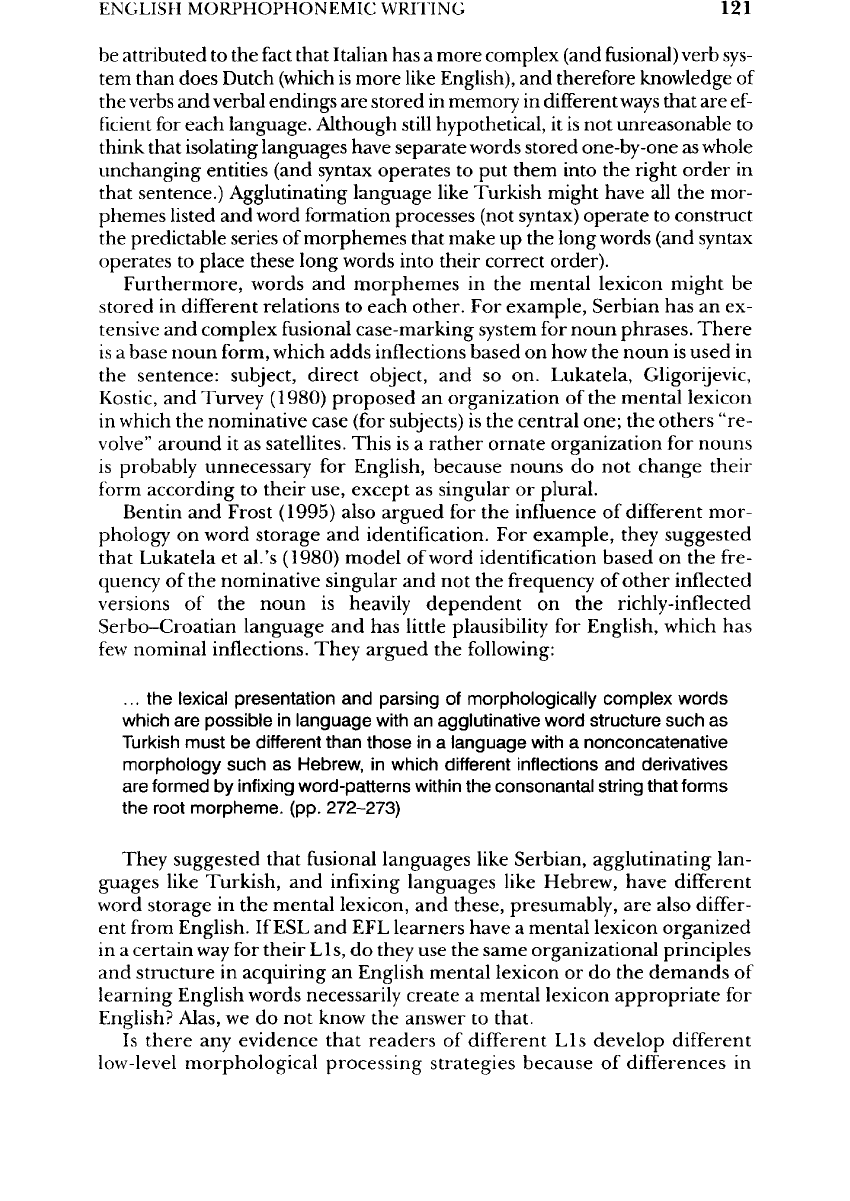
ENGLISH
MORPHOPHONEMIC
WRITING
121
be
attributed
to the
fact
that Italian
has a
more complex (and
fusional)
verb
sys-
tem
than does Dutch (which
is
more like English),
and
therefore knowledge
of
the
verbs
and
verbal endings
are
stored
in
memory
in
different
ways
that
are ef-
ficient
for
each
language.
Although
still
hypothetical,
it is not
unreasonable
to
think
that isolating languages have separate words stored one-by-one
as
whole
unchanging entities (and syntax operates
to put
them into
the
right
order
in
that
sentence.) Agglutinating language like Turkish might have
all the
mor-
phemes listed
and
word formation processes (not syntax) operate
to
construct
the
predictable series
of
morphemes that make
up the
long words (and syntax
operates
to
place these long words into their correct order).
Furthermore, words
and
morphemes
in the
mental lexicon might
be
stored
in
different
relations
to
each other.
For
example, Serbian
has an ex-
tensive
and
complex
fusional
case-marking system
for
noun phrases.
There
is
a
base noun form, which adds
inflections
based
on how the
noun
is
used
in
the
sentence: subject, direct object,
and so on.
Lukatela, Gligorijevic,
Kostic,
and
Turvey
(1980)
proposed
an
organization
of the
mental lexicon
in
which
the
nominative case (for subjects)
is the
central one;
the
others "re-
volve"
around
it as
satellites. This
is a
rather ornate organization
for
nouns
is
probably unnecessary
for
English, because nouns
do not
change their
form
according
to
their use, except
as
singular
or
plural.
Bentin
and
Frost
(1995)
also argued
for the
influence
of
different
mor-
phology
on
word storage
and
identification.
For
example, they suggested
that
Lukatela
et
al.'s
(1980) model
of
word identification based
on the
fre-
quency
of the
nominative singular
and not the
frequency
of
other inflected
versions
of the
noun
is
heavily dependent
on the
richly-inflected
Serbo-Croatian language
and has
little plausibility
for
English, which
has
few
nominal inflections. They argued
the
following:
... the
lexical
presentation
and
parsing
of
morphologically
complex words
which
are
possible
in
language
with
an
agglutinative
word structure such
as
Turkish must
be
different
than
those
in a
language
with
a
nonconcatenative
morphology such
as
Hebrew,
in
which different
inflections
and
derivatives
are
formed
by
infixing
word-patterns
within
the
consonantal
string
that
forms
the
root
morpheme,
(pp.
272-273)
They suggested that fusional languages like Serbian, agglutinating lan-
guages like Turkish,
and
infixing languages like Hebrew, have
different
word
storage
in the
mental lexicon,
and
these, presumably,
are
also
differ-
ent
from
English.
If ESL and EFL
learners have
a
mental lexicon organized
in
a
certain
way for
their
Lls,
do
they
use the
same organizational principles
and
structure
in
acquiring
an
English mental lexicon
or do the
demands
of
learning English words necessarily create
a
mental lexicon appropriate
for
English?
Alas,
we do not
know
the
answer
to
that.
Is
there
any
evidence that readers
of
different
Lls
develop
different
low-level
morphological processing strategies because
of
differences
in

122
CHAPTERS
the
morphological structure
of
their words
or
mental lexicon?
The
answer
here
too is
sketchy,
but
interesting.
We saw
earlier
that patterns
of
derivational
morphology
do not
seem
to be
very
accessible
to
English
speakers unless they have been schooled
in
them,
but
they
can use
mor-
phology
to
read
unknown words
if
they have
the
knowledge.
We
have also
seen that words
in
English
can be of any of the
four morphological types.
This leads
to the
hypothesis that native English readers
do not
rely much
on
consistent morphological processing strategies,
but
rather
have
a
num-
ber of
strategies that they
can
employ
if
necessary, depending
on how
transparent
or
segmentable
the
word
is:
matching
the
perceived word
or
morpheme
to a
word
or
morpheme stored
in the
mental lexicon
or
detect-
ing
pseudo words (that
is,
words that could
be
English
but
aren't
in the
mental lexicon).
If a
word
is
identified
as
unknown,
the
reader
can
sepa-
rate potential morphemes
if
necessary, accessing
the
meaning
of the
words
and
morphemes,
and
recombining
the
pieces.
The
reader
can
also
use
analogy
to
similar known words
to get a
hypothesis about
what
the
word
is and its
meaning.
Schreuder
and
Baayen (1995),
who
proposed
that
different
language-
specific
characteristics
of
morphology
may
affect
the
way
that
the
mental lexi-
con
develops, also assumed
different
"language-specific models
of
morpho-
logical
processing"
(p.
132).
We
might imagine that languages that have
words
made
up
consistently
from
one
type
of
morphological
pattern
might
encourage readers
to use one
strategy
uniformly.
For
example,
the
matching
strategy
is
useful
for
isolating languages.
If the
word
is
found
to be an un-
known
pseudo word,
the
LI
strategy might
be to add the new
word without
any
further analysis because morphological analysis
is not an
option.
Matching
one-to-one
may be
less
useful
for
agglutinating languages. Readers
might have
to do
morphological
analysis
or
analogy
to
process
words
in
read-
ing,
thus, separating, accessing meaning,
and
recombining might
be
fre-
quently
used strategies.
If
students
are
used
to
applying
one
strategy
to the
exclusion
of
others, they
may
show
signs
of
only partial positive transfer
or
negative
transfer
to
English
reading,
which seems
to
require both.
For
example, Chinese writing
doesn't
contain information about mor-
phology
because
it is an
isolating language
not
given
to
morphologically
complex words, although compound words
are
common.
In
addition,
the
sinograms themselves
do not
lend themselves
to
indicating
any
changes
in
the
words that they
encode,
because they
are
printed
"as
is," unlike alpha-
betic writing
which
can
print
the
words
in
present tense
or
past tense, singu-
lar
or
plural, through changes
in
spelling.
Taft
and Zhu
(1995)
discussed
a
number
of
questions concerning morphological processing
in
Chinese
writing;
they made some suggestions
for
morphological processing that
are
quite
different
from
any
ever
proposed
for
English.
It is
quite possible that
Chinese
learners
of
English reading
do not
process
the
grammatical
infor-
mation
from
derivational
and
inflectional morphemes
in
English,
or
they
do not
process
it
efficiently
and
automatically.

ENGLISH
MORPHOPHONEMIC
WRITING
123
Garnham,
Oakhill,
Ehrlich,
and
Carreiras (1995) showed that gender
marking
in
languages like French
and
Spanish
is
used
to
determine refer-
ence between
a
pronoun
and a
noun phrase.
In
French
and
Spanish,
all
nouns
are
either "masculine"
or
"feminine"
and
adjectives, determiners,
and
pronouns must match them.
It
seems like readers
of
Spanish
and
French have developed
a
strategy
to
process
gender
marking
of
nouns,
but
English does
not
have
the
same type
of
gender markings.
In
English,
most
nouns
are
neutral with respect
to
gender
and are
referred
to
with
"it,"
unless there
is
some reason
to
assign them
a
gender
(as in
referring
to
boats
as
she).
French
and
Spanish speakers
will
not be
able
to
rely
on
their
LI
strategy
to
process nouns
and
they
may
lack
the
strategies that English
speakers
develop.
Koda
(1993)
studied second language learners
of
Japanese
(21
Ameri-
cans,
12
Chinese,
and
13
Koreans).
A
sentence completion task measured
knowledge
of
case-marking particles.
The
data confirmed that sentence
comprehension
differs
among second language
readers
of
Japanese
with
varying
LI
backgrounds
and
suggested that reading
skills
transferred
from
native language interact
with
L2
linguistic features
in
shaping pro-
cessing
strategies. Besides
the
potential difference
in
reading
strategies,
ESL
and EFL
learners
are
affected
by
lack
of
knowledge
of
English
inflec-
tional
and
derivational morphology.
The
Japanese
learners studied
in
Schmitt
and
Meara
(1997)
showed
"a
rather
weak awareness
of
derivative
suffixes
and
their
use
[and they] lack convincing mastery
of
even
inflec-
tional
suffixes"
(p.
26).
IMPLICATIONS
FOR ESL
READING INSTRUCTION
As
ESL and EFL
students
are
learning words
in
English, they should
be
building
up
such
a
storage
of
morphemes, rimes,
and
syllables through
di-
rect instruction
and
through extensive reading practice.
This
morpheme
store
will
help with reading
and
with
effective
use of
English dictionaries.
Students,
whose
first
languages
are
isolating, like
Ho, may
have
difficulty
with
the
complex morphological structure
of
some English words.
Their
mental
lexicons
may
need
restructuring
to
include knowledge
of
derivational morphemes
and
they must learn
the
inflectional morphemes
of
English.
If the
LI
writing system doesn't encode morphological changes
in
words, readers
may not
have
efficient
processing strategies like separa-
tion
and
recombination
for
morphological
changes
in
English words, such
as
tense, possessive,
or
plural. They
may be
relying
on a
simple matching
strategy,
which
is not
effective
unless they have
a
perfect match
for
each
word
in
their mental lexicon.
Students
who
speak Hebrew
may
have
LI
processing strategies that
focus
more
on
infixed
morphological changes rather than
on the
prefixed
and
suffixed
morphology
of
English. This would
be
similar, say,
to
detecting
the
difference
between
sit and
sat,
for
example,
which
is not a
very
useful
strat-

124
CHAPTERS
egy
to
generalize
for
English. English
has a
small
set of
verbs
that
form
their
past
tenses
by
"infixed"
(in a
way)
vowel
changes; although these words
may
be
frequent,
their
number
is
small. Students like
Ho may
benefit from direct
instruction
in
reading derivationally complex words
and
inflectional end-
ings
so
that their lexical processor
works
optimally using matching, separat-
ing
and
recombining,
and
analogy
to
morphologically similar words.
Students like
MariCarmen
and
Despina come from languages that
are
largely
fusional
with complex verbal systems
of
many inflectional endings
and
complex noun, adjective,
and
pronoun agreement
systems
that
use
gender
and
case markings
to
show
relations
and
reference. This rich
and in-
formative
inflectional morphology
is
probably processed with more atten-
tion than
the
meager inflectional morphology
of
English, which provides
few
cues
to
verb tense
and
noun agreement. Japanese uses
a
system
of
parti-
cles
(not inflections)
to
indicate
the
functions that nouns have
in
sentences
(e.g.,
subject, object, indirect object, etc.). Readers
who
come
from
these
languages
need
to
learn that English uses strict word
order
more heavily
to
encode meaning relations. They, like Mohammed
and Ho,
benefit
from
di-
rect instruction
in
derivational
and
inflectional morphology,
and
strategies
like
separating
and
recombining. Students from Latin-
or
Greek-based lan-
guages have
the
benefit
of
shared derivational morphology
with
English
(pre-,
post-,
-ment, -tion, etc.); they
may
focus more exclusively
on
Ger-
manic
morphology
(-ness,
-dom,
-ly).
For
some
ESL and EFL
advanced readers,
it may be
useful
to
comment
on the
fairly
consistent phonological rules
of
English which
affect
the
pro-
nunciation
of
derived words (press-pressure)
and
therefore complicate
our
spelling.
This
may
enable students
to
sound
out
words more
effec-
tively
to
determine
if
they know
the
word
by
sound
and to
discard
a
mean-
ing-based reading strategy
for
words that
are
hard
to
pronounce.
It may
even
be
useful
to
tell students that English writing
is not
just phonemic
but
also
morphemic
in
that
the
accurate representation
of
sound
is
sacrificed
to
maintain
the
semantic connection between words that
can be
perceived
if
the
root morphemes
are
spelled consistently.
Our
system tries
to
strike
a
balance between representing phonemes (sound)
and
morphemes (small
meaning units)
and
sometimes
the
need
to
represent morphemes over-
rides
the
need
to
represent
sound
accurately.
This
may
help students form
a
lexical entry
for a
word
and see
meaning relations between words,
or at
least
connect words
in the
mental lexicon.
The
point
of
morphological
in-
struction
and
practice with processing strategies must
be to
reduce
the
cognitive
load
associated
with
the
task,
so
students must
understand
the
system,
practice
the
strategy overtly,
and
generalize
the
strategy
to all of
their
reading.
It is
only then that they
will
make
use of
English morpholog-
ical
cues
in
reading.
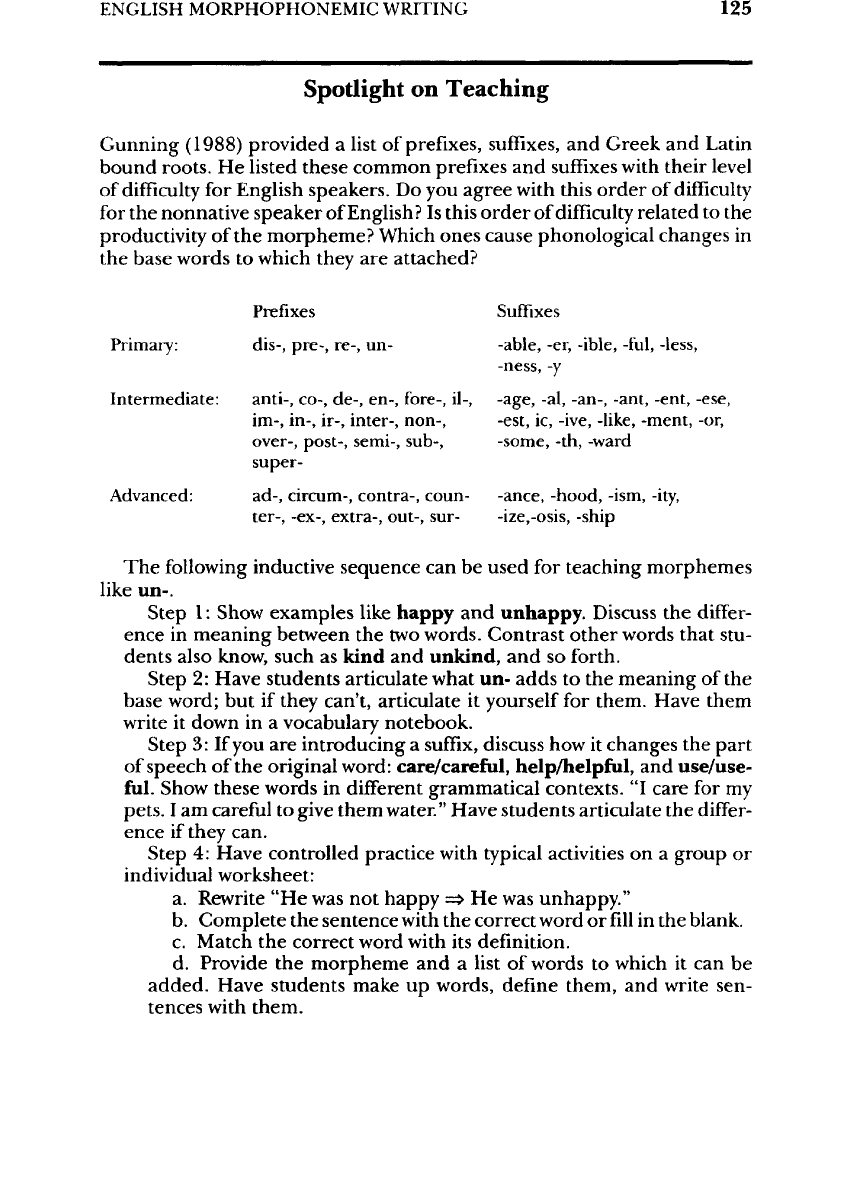
ENGLISH
MORPHOPHONEMIC
WRITING
125
Spotlight
on
Teaching
Gunning
(1988)
provided
a
list
of
prefixes,
suffixes,
and
Greek
and
Latin
bound
roots.
He
listed these common prefixes
and
suffixes
with
their level
of
difficulty
for
English speakers.
Do you
agree
with this
order
of
difficulty
for
the
nonnative speaker
of
English?
Is
this
order
of
difficulty
related
to the
productivity
of the
morpheme? Which
ones
cause phonological changes
in
the
base words
to
which they
are
attached?
Prefixes
Suffixes
Primary:
dis-,
pre-,
re-,
un-
-able, -er,
-ible,
-ful,
-less,
-ness,
-y
Intermediate: anti-, co-, de-,
en-,
fore-,
il-,
-age,
-al,
-an-,
-ant, -ent, -ese,
im-,
in-,
ir-,
inter-,
non-, -est,
ic,
-ive, -like,
-ment,
-or,
over-,
post-,
semi-,
sub-,
-some, -th, -ward
super-
Advanced:
ad-,
circum-,
contra-,
coun- -ance,
-hood,
-ism, -ity,
ter-,
-ex-,
extra-,
out-,
sur- -ize,-osis, -ship
The
following inductive sequence
can be
used
for
teaching morphemes
like
un-.
Step
1:
Show examples like happy
and
unhappy. Discuss
the
differ-
ence
in
meaning between
the two
words. Contrast other words that stu-
dents also know, such
as
kind
and
unkind,
and so
forth.
Step
2:
Have students articulate what
un-
adds
to the
meaning
of the
base word;
but if
they can't, articulate
it
yourself
for
them. Have them
write
it
down
in a
vocabulary notebook.
Step
3: If you are
introducing
a
suffix,
discuss
how it
changes
the
part
of
speech
of the
original word: care/careful,
help/helpful,
and
use/use-
ful.
Show these words
in
different
grammatical contexts.
"I
care
for my
pets.
I am
careful
to
give them
water."
Have students articulate
the
differ-
ence
if
they can.
Step
4:
Have controlled practice
with
typical activities
on a
group
or
individual
worksheet:
a.
Rewrite
"He was not
happy
=>
He was
unhappy."
b.
Complete
the
sentence with
the
correct
word
or
fill
in the
blank.
c.
Match
the
correct
word with
its
definition.
d.
Provide
the
morpheme
and a
list
of
words
to
which
it can be
added. Have students make
up
words, define them,
and
write sen-
tences with them.

126
CHAPTERS
e.
Contrast
the
morpheme with others that
are
like
it, if
any:
-less,/
-ful,
preVpost-.
Step
5:
Have guided practice, such
as the
following:
a.
Have
a
structured language experience, using words
with
the
morpheme.
b.
Bring
in
examples
of the
morpheme
from
other books
or
read-
ings.
They should write these
in
their vocabulary notebook.
c.
Allow
students
to
identify
the
morpheme
in the
reading when
they
see it. You
probably selected this morpheme
for a
minilesson
be-
cause
it
appears
in
something that your
class
is
reading.
Now
you
choose
one of the
morphemes
from
Step
5 and
write
a
lesson
plan
for
teaching
it.
DISCUSSION QUESTIONS
1.
Have
you
figured
out the
naked
and
baked example?
If
not, look
them
up in the
dictionary
and try a
little morphological analysis.
2.
What
is
strange about
the
pronunciation
of the
word "beloved"
with
three syllables
(be-lov-ed)?
Where
did
this pronunciation come
from?
3. In
which
"order"
were
the
suffix
and
prefix added
to the
word
hurry
to
make unhurried?
That
is, was the -ed
added
first and
then
the
prefix
un- or
vice versa? What
is
your reasoning
for
your
an-
swer?
Is
this
the
same reasoning
for
daunt
=>
undaunted
or
unbri-
dled
from
bridle?
4.
Besides derivation,
one
common word formation process
in
Eng-
lish
is
compounding. Noun compounds
may be
made
up of
noun-noun combinations (tomato juice),
Adjective-noun
combina-
tions
(blackbird),
and
even verb-particle combinations
(pick
up).
Say
these sentences. What
do you
notice about
the way
that
the
compound
is
pronounced
in
"i,"
when compared
to the
other sen-
tence
in
each pair? What
is the
difference
in
meaning?
a.
i.
Please bring
me
some
orange
juice.
ii.
This
is the red
juice
and
that
is the
orange juice.
b. i. The
president
lives
in the
White
House,
ii.
The
white house
on the
corner
is
new.
c.
i. She
drives
a
pick-up truck.
ii.
Please pick
up
some eggs
on
your
way
home.
5.
Is
there
any
rule about when
to
write compound words
as one
word,
with
a
hyphen,
or as two (or
more) words?
6. If you
know another language, think about
its
morphology:
for ex-
ample,
it may be
isolating, polysynthetic, agglutinating,
fusional,
or
a
combination
of
these. What evidence
do
you
have
for
your answer?
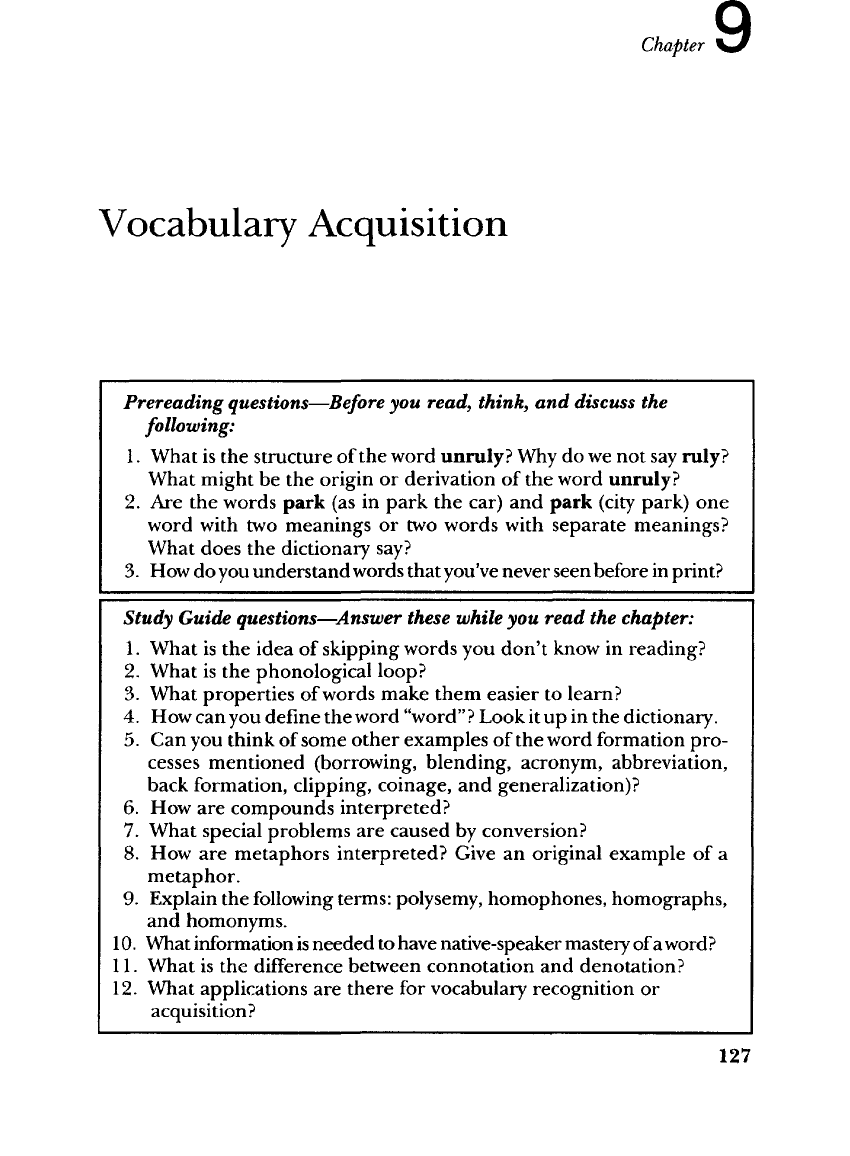
Chapter
9
Vocabulary
Acquisition
Prereading
questions—Before
you
read,
think,
and
discuss
the
following:
1.
What
is the
structure
of the
word unruly?
Why do we not say
ruly?
What
might
be the
origin
or
derivation
of the
word unruly?
2.
Are the
words park
(as in
park
the
car)
and
park
(city
park)
one
word
with
two
meanings
or two
words
with
separate meanings?
What
does
the
dictionary
say?
3.
How
do
you
understand words that you've never seen before
in
print?
Study
Guide
questions—Answer
these while
you
read
the
chapter:
1.
What
is the
idea
of
skipping words
you
don't
know
in
reading?
2.
What
is the
phonological loop?
3.
What
properties
of
words make them
easier
to
learn?
4.
How
can
you
define theword "word"? Lookitup
in the
dictionary.
5.
Can you
think
of
some
other
examples
of the
word formation pro-
cesses mentioned (borrowing,
blending,
acronym, abbreviation,
back formation, clipping,
coinage,
and
generalization)?
6.
How are
compounds interpreted?
7.
What special problems
are
caused
by
conversion?
8.
How are
metaphors interpreted? Give
an
original example
of a
metaphor.
9.
Explain
the
following
terms: polysemy, homophones, homographs,
and
homonyms.
10.
What information
is
needed
to
have native-speaker mastery
of
a
word?
11.
What
is the
difference between connotation
and
denotation?
12.
What applications
are
there
for
vocabulary recognition
or
acquisition?
127
